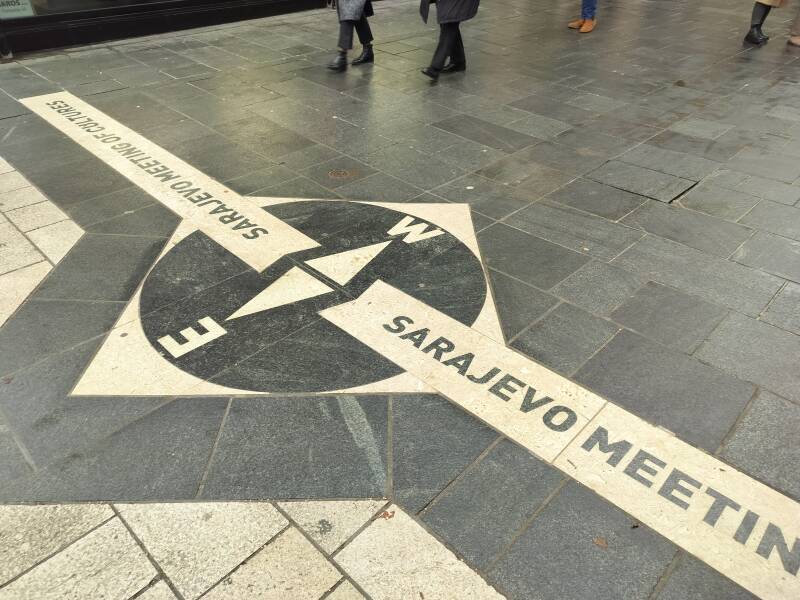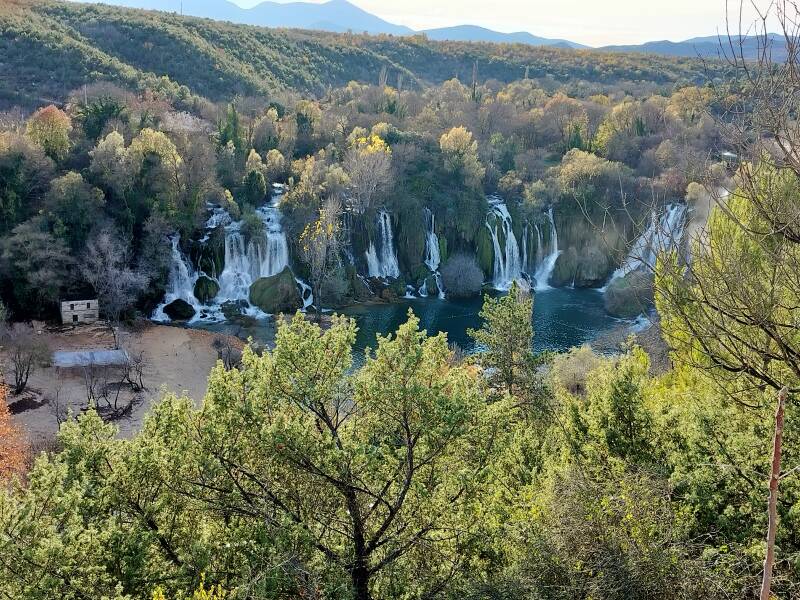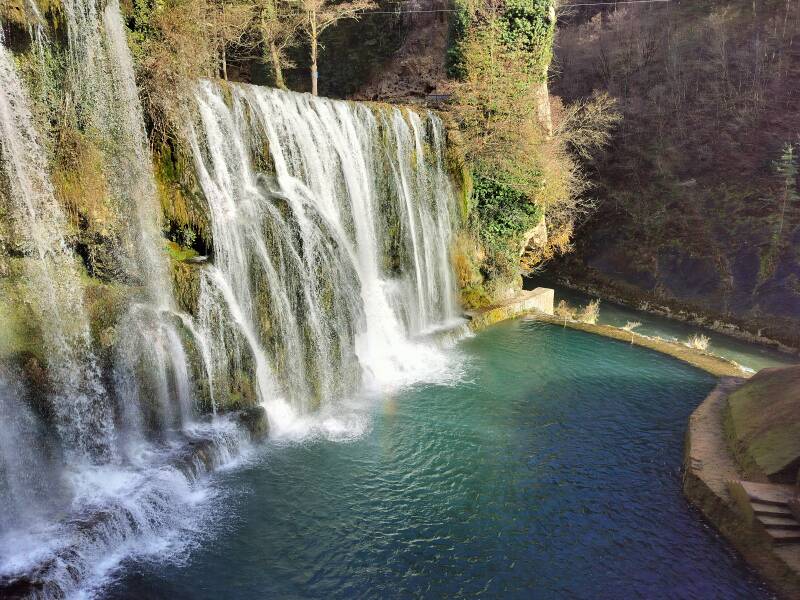As you work your way through the Balkans, one country stands out for its raw authenticity, layered history, and stunning natural beauty: Bosnia and Herzegovina. Often overlooked on the typical European tourist trail, this country offers an unfiltered, enriching experience unlike anywhere else. It’s not part of the EU or Schengen zone, which means it remains pleasantly untouched by mass tourism. And that extra step to get here? It makes your experience all the more rewarding.
🌍 Why Visit Bosnia & Herzegovina?
✅ Authentic Travel: Less touristy than Croatia or Slovenia
✅ Fascinating History: From empires to modern conflict and recovery
✅ Incredible Landscapes: Dinaric Alps, Kravica Waterfalls & more
✅ Warm Hospitality: Locals eager to connect and share their stories
✅ Affordable Adventures: Excellent value for food, lodging, and tours
🕰 A Glimpse Into Bosnia’s Complex History
Bosnia and Herzegovina has long been a pivotal crossroads between East and West, its story etched by empires, divided by faiths, and profoundly scarred by recent war. Understanding this complex past makes visiting today even more remarkable.
Bosnia has long been a cultural crossroads. Over the centuries, it’s been shaped by Illyrians, Romans, Slavs, Ottomans, and Austro-Hungarians.
🏛 Empires, Identity & Conflict
- Once home to Illyrians and Romans, then Slavic tribes formed early kingdoms.
- The Ottoman Empire's conquest in 1463 brought centuries of influence, leaving a strong Islamic and architectural legacy still vibrant in cities like Sarajevo and Mostar.
-
Austro-Hungarian rule (1878–1918) brought industry and European architecture. Sarajevo became the site of Archduke Franz Ferdinand’s assassination in 1914, which sparked WWI.
⚔️ Yugoslavia, WWII & Tito
- After WWI, BiH became part of the Kingdom of Yugoslavia.
- WWII brought brutal occupation and devastating inter-ethnic conflict.
- Post-WWII, Bosnia became one of the six republics in Communist Yugoslavia under Tito, who managed to largely suppress ethnic tensions for decades.
💣 The 1990s War & Devastation:
-
Following a referendum in 1992, Bosnia and Herzegovina declared independence, triggering a horrific war involving Serbia and Croatia.
-
The Siege of Sarajevo (1992–1996) lasted nearly four grueling years.
-
Ethnic cleansing, war crimes, and genocide (most infamously at Srebrenica) devastated the population, particularly the Muslim Bosniaks. The beautiful city of Mostar and its Old Bridge were deliberately destroyed.
🕊️ The Dayton Accords & Post-War Recovery:
-
The Dayton Peace Agreement (1995) ended the war and established the current complex power-sharing government designed to represent Bosniaks, Serbs, and Croats.
-
While deep divisions and the scars of war remain, Bosnia and Herzegovina has made incredible strides. It’s inspiring to see cities once separated by ethnicity now fostering growing integration. Many locals, even those who lived through the horrors, express a desire for peace and often travel freely to neighboring countries, emphasizing that human connections transcend politics.
🏙 Sarajevo: Where East Meets West
Your Bosnian journey will likely lead you to Sarajevo, the capital and the vibrant, emotional heart of the country. This is a city where centuries of history, imperial grandeur, the raw scars of recent conflict, and an incredible spirit of resilience all converge.
-
🎧 Start with a Walking Tour: As usual, I recommend starting with a walking tour in Sarajevo. Guides often share incredibly moving personal stories. My guide, for instance, lived through the nearly four-year siege as a teenager. Her firsthand account of fleeing her hometown and surviving in the besieged city brought a depth of understanding that no book could offer. Beyond the poignant history, these tours are invaluable for getting your bearings and receiving those precious local tips.
-
Step into History at Baščaršija (Old Turkish Bazaar): Immerse yourself in the historic Ottoman quarter. Wander its narrow, cobblestone streets, watch coppersmiths at work in tiny shops, breathe in the aroma of Bosnian coffee from traditional cafes, and, of course, find some of the city’s best ćevapi spots.
- Witness the "Meeting of Cultures": One of the most fascinating aspects of Sarajevo is its tangible blend of East and West. Stroll down Ferhadija street, and you'll literally cross a line marked on the pavement: the "Sarajevo Meeting of Cultures." Look one way, and the architecture, minarets, and bustling bazaars feel distinctly Ottoman, like a miniature Istanbul. Turn 180 degrees, and you're met with grand Austro-Hungarian facades reminiscent of Vienna. It’s a stunning visual representation of the city’s layered heritage.
- The Spark of WWI: The Latin Bridge & Assassination Site: History buffs will know that Sarajevo was where the 20th century truly exploded. Visit the picturesque Latin Bridge. While often misattributed as the site itself, the fateful assassination of Archduke Franz Ferdinand of Austria-Hungary and his wife Sophie in 1914 actually occurred on the street corner right next to it. The exact spot where assassin Gavrilo Princip stood is usually marked, offering a chilling connection to a global turning point. This event sparked WWI.
🌉 Mostar: The Iconic Bridge, Ottoman Charm & A City Still Healing
Journeying southwest from Sarajevo, you'll arrive in Mostar, a city whose very name is synonymous with its stunning Ottoman-era architecture and, most famously, its iconic bridge. Like Sarajevo, Mostar was profoundly impacted by the devastating war of the 1990s, and while many of its historic buildings have been beautifully restored, you can still see poignant reminders of the conflict. Today, it's a city of captivating beauty and complex, healing memory.
-
Stari Most (Old Bridge): A Symbol of Resilience & UNESCO Jewel: The undisputed heart and soul of Mostar is its Stari Most. This elegant, arched 16th-century Ottoman bridge is an absolute masterpiece of Islamic architecture in the Balkans. To see it arching gracefully over the vibrant turquoise Neretva River is truly breathtaking. Its history is also one of profound resilience. The bridge was destroyed by Croat shelling during the Bosnian War in 1993. Its meticulous reconstruction, completed in 2004, using many of the original stones salvaged from the river and traditional Ottoman construction methods, transformed it into a powerful global symbol of reconciliation and the endurance of cultural heritage.
-
Wander Kujundžiluk (Old Bazaar): On either side of the Stari Most, the charming, narrow cobblestone streets of Kujundžiluk make up Mostar’s historic bazaar. Here, you can immerse yourself in the Ottoman atmosphere, browse shops overflowing with traditional crafts, intricate copperware (especially coffee sets), colorful carpets, and local souvenirs. It's a perfect place to find a unique keepsake.
-
Reflect at War Photo Exhibitions: You'll likely find small but powerful War Photo Exhibitions near the bridge or in the Old Town. These often feature stark, poignant images of Mostar during the siege and the destruction of the Stari Most, offering a crucial, sobering perspective on what the city endured.
-
Understanding Mostar's Recent Past: A City Divided & Reconnecting: It's important to understand that for a long period after the war, Mostar was deeply divided along the Neretva River, with Bosniaks predominantly on the eastern side and Croats on the western. While tensions have significantly eased and there's much more intermingling now – with people crossing freely and life slowly returning to a shared urban space – this recent history forms an important context for understanding the city's social fabric. You'll see new buildings and restoration efforts throughout, but also some structures still bearing the visible scars of conflict.
- Kravica Waterfalls: While Mostar itself is captivating, an excursion to the nearby Kravica Waterfalls is, in my opinion, an absolute must-do. About an hour's drive away, Kravica features a breathtaking, wide crescent of around 20 individual waterfalls cascading dramatically into a beautiful emerald-green lake. In the summer, it's a popular spot for swimming and picnicking. The sheer scale and beauty are incredible. It genuinely stacks up against any waterfall I've ever seen!
- Blagaj Tekke (Dervish Monastery): A serenely beautiful historical monastery uniquely built at the source of the Buna River, right at the base of a towering cliff.
- Počitelj: A remarkably preserved, fortified Ottoman-era village clinging picturesquely to a hillside, offering great views and a step back in time.
🏞 Jajce: Waterfalls, Fortress & Small-Town Charm
Jajce is a smaller city but rich in natural and historical sights, and is a nice city to also visit. The top attractions I enjoyed are:
-
💦 Pliva Waterfall: A waterfall right in the center of town!
-
🏯 Jajce Fortress: Panoramic views over the city and surrounding hills.
-
⛪ Underground Catacombs: A medieval crypt once used by Bosnian nobles.
-
🗺️ Old Town: Steep streets, local bakeries, and warm hospitality.
🍽️ Tasting Bosnia & Herzegovina: Seriously, You HAVE to Eat This Stuff!
Alright, let's get down to what truly matters on any trip (at least for me): the food! And let me tell you, after some of my culinary adventures elsewhere, I was thrilled and very, very happy with what Bosnia and Herzegovina brought to the table. It’s hearty, it’s flavorful, and it often showcases those fantastic Ottoman and Balkan influences. If you're a meat-eater, prepare to loosen your belt because you are going to eat very well here!
-
Ćevapi (Ćevapčići): The Undisputed King & My New Obsession!
If there's one food you try, make it ćevapi. It's the national dish, and for outrageously good reason. Picture this: small, perfectly grilled, hand-rolled sausages (usually a mouthwatering mix of beef and lamb) tucked into warm, fluffy somun (flatbread), served with a generous pile of fresh, chopped raw onions, and other toppings depending on where you go. It’s simple, but I could have eaten ćevapi for breakfast, lunch, and dinner. -
Pljeskavica: The Other Grilled Meat Hero
If ćevapi is king, pljeskavica is its equally impressive royal sibling. This is basically a large, spiced minced meat patty, also grilled to perfection, and often served in somun like ćevapi, or sometimes more like a glorious, rustic burger. Equally satisfying. -
More Grilled Goodness:
Bosnians are masters of the grill. You'll find fantastic grilled lamb, various cuts of beef, chicken, and especially delicious freshwater fish (look for trout!). If it can be grilled, they grill it, and they grill it well. -
Burek & Other "Pita" Perfection (Savory Pastry Heaven!):
Step into any pekara (bakery), and you’ll be greeted by an array of golden, flaky phyllo dough pastries. Burek, the most famous, is traditionally rolled and filled with spiced minced meat. But don't stop there! Its equally delicious cousins include:-
Sirnica: Stuffed with cheese – creamy, salty, delightful.
-
Zeljanica: A fantastic mix of spinach and cheese.
-
Krompiruša: Filled with seasoned potatoes.
-
-
Dolma & Sarma: Stuffed Delights
These are common throughout the Balkans and Middle East: vegetables (like peppers, onions, zucchini for dolma) or cabbage/grape leaves (sarma) lovingly stuffed with a savory mix of minced meat and rice, then simmered to perfection. - Bosnian Coffee (Bosanska Kafa / Kahva): It's Not Just Coffee, It's an Event!
Prepare yourself, because Bosnian coffee is an experience, a ritual, a statement. It’s strong, rich, and served in a traditional copper long-handled pot. It’s very similar to Turkish coffee, but as my guide in Mostar cheekily put it, with a twinkle in his eye: "Bosnian coffee is better, that is how you can tell the difference." It’s meant for slow enjoyment, good conversation, and watching the world go by. Embrace the pace!
💬 Final Thoughts: A Journey That Stays With You
Bosnia and Herzegovina is not a place you’ll find on most mainstream European travel itineraries – and that’s precisely what makes it so incredibly rewarding and special. Traveling here offers:
-
✅ Stunning, often untouched, natural beauty and charming historic towns.
-
✅ A chance to connect with deep cultural and religious diversity.
-
✅ Fewer crowds and more authentic, local experiences.
-
✅ A powerful opportunity to witness the remarkable resilience of a nation that’s rebuilding with after profound tragedy.
This isn’t just about sightseeing; it’s about connecting with people, listening to their stories, and seeing firsthand how far a country can come. Bosnia and Herzegovina truly captured a piece of my heart, and I urge you to let it capture yours.







Add comment
Comments
...sausages🤨...beef & lamb😌